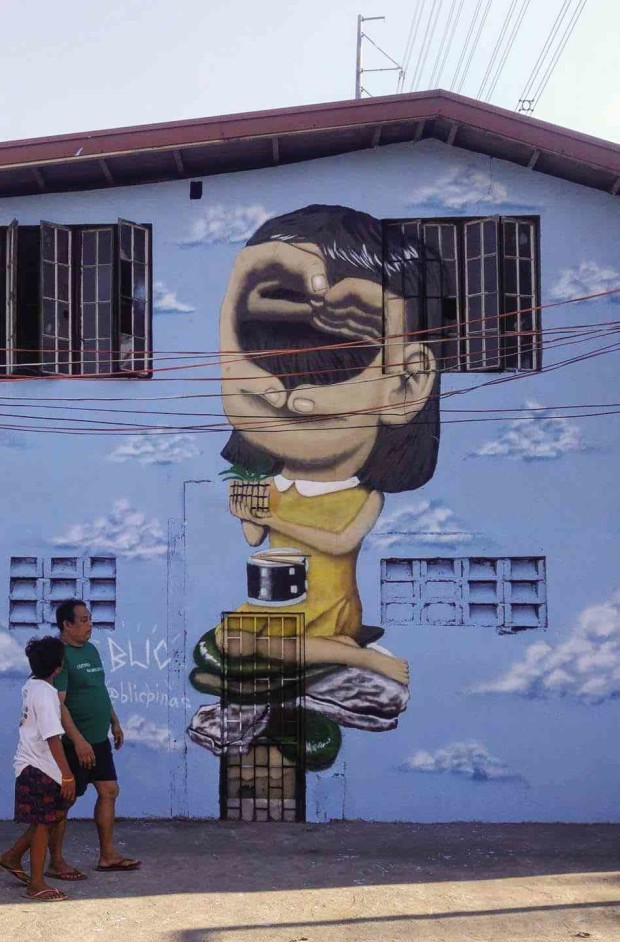Dead walls come to life in Cavite mural festival

COLOR SPLASH. A two-floor structure in the village of Panapaan 7 in Bacoor City in Cavite gets a splash of color through a surrealist image of a girl painted by muralist “BLIC.” —PHOTO COURTESY OF CAVITE ACTIVE PHOTOGROUP
DASMARIÑAS CITY—While holding an umbrella with one hand, the Japanese graffiti artist clutched a can of spray paint with the other and scribbled “Very1” on the wall inside the decrepit building that was once a construction warehouse. It was the tag (graffiti name) of the 38-year-old from Osaka.
Very1 and another, Italian Guido Gee, 36, who is known by his tag, “ANFX,” completed their works (about 6-foot-high and 5-foot-wide) under two hours despite the intense summer heat.
The old structure at the junction of the Aguinaldo Highway is where visual artists, bordering on art and vandalism, chose to leave their mark. It is among the abandoned buildings and empty façades in Cavite province which have sprung back to life with indecipherable scrawls and grotesque creatures in what is, perhaps, a fusion of art and angst.
Gee, who works for a telecommunications company in Spain, has been doing graffiti for 20 years.
“Before, I used to do it maybe just for competition with the other guys, but [over the years], it has become for my personal evolution that I have come to know my style,” he said.
Article continues after this advertisementHe had done a couple of artworks in Metro Manila and Cebu City.
Article continues after this advertisementWhat brought foreign and local graffiti and mural artists to Cavite, 21 kilometers south of Metro Manila, was the “Kulay Cavite,” a two-week mural festival that kicked off on April 22.
‘Notoriety’
Kulay Cavite is probably the “first and the biggest” attempt by the street art subculture to gain what the artists call “notoriety” and, ultimately, public acceptance. The common theme is local culture infused with the artists’ own styles, said organizer Tanya Jizelle Pastor.
About 40 visual artists from various groups committed to paint 15 spots, mostly the facades of private and public buildings, in 10 cities and towns—Bacoor, Noveleta, Kawit, Cavite, Rosario, Trece Martires, Imus, Tanza, Dasmariñas and General Trias.
“We wish to gain notoriety for street art—that we are not just vandals but it (street art) can become an alternative tool to promote local tourism and cultural identity,” Pastor said.
Pastor, 25, a broadcast journalism graduate, thought of such an “organized” session with visual artist and call center agent Christian Cresencio, 33, who carries the tag “Lamok Skito.”
Since the activity was in partnership with the municipal government of Kawit, the groups of artists made sure they had the permission from the owners of the structures to paint the walls.
“We want to break the notion that we are [drug] addicts or street gangsters. Many of us are professionals, too,” Pastor said.
While not everyone appreciates their art, “we want to show that it is more than just the distorted images of genitals we often see,” she said. “We, too, can talk about social injustices and promote social change.”
Local colors
Incorporating local flavors, muralist Allan Rommel Adia, also known as “BLIC,” would be working on a mural with his signature image of a hand that carries a marching band and “tahong” (green mussels). Bacoor City is known for the traditional marching bands, as well as for its tahong industry.
In the historical town of Kawit, the mural group “Ang Gerilya” is painting a massive Philippine flag, while in Dasmariñas City, artists are working on a mural of butterflies. Dasmariñas is known for its “Paru-paro” (butterfly) Festival.
“It started as a hobby but has become a form of expression,” said graffiti artist “Flip1.”
Flip1, 39, is regarded by fellow artists as a pioneer in Philippine graffiti that started in the early 1990s. His first work was in a canal somewhere in Makati City.
Flip1, who runs design studios, is known for his stylized Baybayin (ancient Filipino script) characters influenced by New York’s hip-hop culture.
The National Commission for Culture and the Arts pledged P300,000 for Kulay Cavite. The money, Pastor said, would be used to buy paint and to cover travel expenses of artists from Metro Manila.
Art in a public space has a shorter life span than other forms, she said. “[But] we’re pretty sure they won’t tear down the walls anytime sooner.”
“Anyway, it doesn’t matter [how long the artwork stays]. We are aware [that street art] lasts only up to some point. What’s important is for the public to see them,” she said.